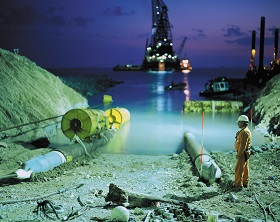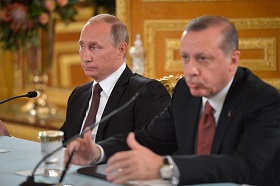To assess the current state and development prospects of Russia–Turkey energy relations, it is necessary to take a closer look at the changes that have taken place on Turkey’s domestic energy market, the key features of its energy policy, and the possibilities of using the country’s transit potential. It is also important to evaluate the risks associated with pursuing Russian interests in the country and the surrounding region.
State of Turkey’s Domestic Energy Market
Turkey’s energy consumption has been increasing steadily in the recent years. In 2005–2015, Turkey’s energy use increased by 46 per cent, from 45 million tonnes of oil equivalent to 131 million tonnes. The country has still a long way to go before its energy consumption peaks: in 2015 alone, Turkey’s domestic demand for energy resources rose by 7 per cent [1]. This is in stark contrast to EU countries, where the general demand for energy resources has gone down. Up until 2014, the country saw a steady rise in the consumption of coal, natural gas and petroleum products; however, that trend was broken in 2015: coal and natural gas consumption decreased, while the demand for liquid hydrocarbon fuels continued to grow. In addition, energy consumption has continued to expand, although growth slowed down considerably in 2015 compared to the previous year (3 per cent in 2015 against more than 10 per cent in 2014), while still remaining among the highest rates in Europe [2]. The 2016 figures will show how stable the new trends are.
Turkey’s energy balance is fairly diversified, oil, gas and coal account for about 30 per cent each, while the remaining 10 per cent is distributed equally among renewable sources: hydropower, biofuels and waste, and newer renewable energy sources (solar, wind and geothermal power). In the recent years, the shares of hydroelectric power and renewable energy sources in the country’s energy balance have been growing at impressive rates, outpacing the rest of Europe (in 2015, the consumption of energy from these renewable sources increase by 65 per cent and 35 per cent, respectively, compared to 2014) [3].
The main priority of Turkey’s energy policy is to ensure the country’s energy security through the use of local energy sources, and at minimal cost. Furthermore, Turkey is seeking to diversify the network of energy suppliers, transportation channels and industry technologies involved. The increase in the share of renewable energy sources, as well as the addition of new sources to the “energy basket” (including nuclear energy) and the intensification of its efforts to explore and develop hydrocarbon resources both inside the country and abroad, are also viewed by experts as priorities in terms of Turkey’s energy security.
Major Areas of Russia–Turkey Energy Cooperation
Russia is interested in the stable export of hydrocarbons, the diversification of oil and gas transport routes linking it to external markets, and the export of nuclear technologies. As such, it has always regarded Turkey as one of its key energy partners in Europe.
Energy cooperation between the two nations can be split into several major areas:
- Trade in energy products, primarily the flow of Russian natural gas to Turkey, is the fastest developing area.
- Russia’s oil and petroleum products are shipped through the Turkish Straits, with a similar transit route for natural gas being a possibility.
- Russia’s foreign direct investment in the country’s energy industry, including the power generation sector, has been increasing, specifically in nuclear energy, energy equipment supplies and maintenance services.
- Joint projects are being carried out to in the exploration and production of hydrocarbon resources in Russia and third countries.
Oil Industry
Russia–Turkey cooperation in the oil sector is fairly diverse. The Turkish company TPAO carries out joint oil production projects with Russian companies, specifically, the development of the Baituganskoye field in the Volga-Ural region. It is also a member of the consortium that is currently developing the Shah Deniz field in Azerbaijan, along with Russia’s LUKOIL.
LUKOIL holds a share of the Turkish retail market for petroleum products via a subsidiary company.
Up to 150 million tonnes of mostly Russian crude oil pass through Turkey’s Bosphorus and Dardanelles Straits every year, which makes the country one of Russia’s key strategic partners on the global oil market.
At the same time, the negative experience with the Samsun – Ceyhan pipeline project, which was discarded in 2013 because of its poor economic value, should not be ignored [4].
Gas Industry
The gas sector is the unquestionable priority of Russia–Turkey economic cooperation. It is also one of its most sensitive areas. Up until 2015, Russia’s gas exports to Turkey had been increasing gradually. The gas is pumped to the country via the Trans-Balkan and the Blue Stream pipelines (each boasting a capacity of 16 billion cubic metres) [5]. Turkey has become the second largest European buyer of Russian gas.
After Russia backed out of the South Stream gas pipeline project, Turkish Stream became the most promising project for the two nations. The route is planned to link the Russkaya compressor station with the western part of Turkey along the bottom of the Black Sea, and then running further on to the Greek border overland to the location of a future gas hub. The project originally involved the construction of four separate lines with a total capacity of 63 billion cubic metres of gas, but other downsized options were also considered, including two lines with a total capacity of 32 billion cubic metres. The current plan is to build a single line with a capacity of 15.75 billion cubic metres of gas during stage one of the project to carry gas to consumers in Turkey [6].
Whether or not the second, and possibly even the third and fourth lines carrying gas to consumers in Europe, will be implemented is conditional on the stance of the European Union.
On October 10, 2016, the project was given a green light in an intergovernmental agreement signed by the Joint Intergovernmental Commission on Trade and Economic Cooperation. The agreement provides for the construction of two lines. The two lines are expected to be completed before December 2019, with the first shipments intended for Turkish consumers.
It should be noted, however, that at the recent RIAC roundtable meeting on Russia–EU relations during the Slovak Presidency of the Council of the European Union held on November 2, 2016, European energy experts decisively rejected Russia’s proposal to supply natural gas via the Turkish Stream project, which challenges the success of Gazprom’s plans to stop gas transit via Ukraine after the current contract expires in 2019, as well as the very creation of a gas hub.
Electric Power Industry
Another key area of Russia–Turkey bilateral cooperation is the electric power sector, primarily nuclear energy.
Over the past 15 years, the Turkish power industry has developed primarily through the construction of thermal power plants and hydroelectric power plants. However, these extensive measures will not be enough to meet the demand for electric power if demand is set to rise within the range of 5–9% per year over the next few years [7]. The low energy efficiency of Turkey’s manufacturing and housing and utilities sectors is another contributing factor here. For instance, the level of technical and non-technical electric power loss is almost three times as high as in western countries [8]. A shortage of reserve generating capacity is expected to hit the country after 2018.
The Turkish government sees nuclear power as one of the most important elements of its energy policy, aimed at meeting the increasing energy demand on the one hand, and balancing out the country’s relative dependence on the imports of hydrocarbon resources, primarily gas, on the other.
The country’s goal is for nuclear power to meet at least 5 per cent of the total demand for primary energy resources in the period until 2020, and at least 10 per cent by 2030. Furthermore, the government also sees as its separate task the creation of a national nuclear industry which would at the very least enable Turkish companies to take part in new nuclear power plant construction projects.
The need to develop nuclear power in Turkey first came into focus in the early 1970s. But it had very little to show for its efforts over the next three decades. Finally, in 2007, the country adopted a law regulating the construction and operation of nuclear power plants. In March 2010, Turkey and South Korea signed a preliminary agreement on the construction of the Sinop Nuclear Power Plant. But the project stalled, and the only thing that came of it was a joint report.
In May 2010, Russia and Turkey reached an agreement on the construction of the Akkuyu Nuclear Power Plant in Mersin Province on the Mediterranean coast. The project includes four nuclear power units with a capacity of 1.2 gigawatts each along the lines of the Russian NPP-2006 project of pressurized water reactors. The total construction cost of Turkey’s first nuclear power plant is estimated at $20 billion.
However, the timeframes for the project have been revised several times. According to the latest data, the first nuclear power unit at the Akkuyu Nuclear Power Plant will be operational by 2020, with the remaining three units to be put into service in each successive year until 2023 [9].
It should be mentioned that during the political crisis of 2015, both Russia and Turkey made reserved or even moderately optimistic statements regarding the project.
Turkey’s second nuclear power plant, to be built at Sinop, is currently in the design stages. Russia has repeatedly shown interest in the project. However, according to the current agreement, the construction project will be carried out by the France–Japan ATMEA consortium. On the whole, we can say that, as far as its nuclear power industry is concerned, Turkey tends to hold drawn-out negotiations, vehemently protect its interests and switch between different partners. For instance, before it finally picked the ATMEA consortium, it had already made deals with South Kore,a and later Japan (including the change of the counterparty), France, Canada and China regarding the Sinop Nuclear Power Plant.
Russian companies have shown strong interest in gas-fired electricity generation projects in Turkey. To consider business development opportunities in Turkey, Inter RAO set up Inter Rao Turkey Enerji Holding. In late 2012, the company bought a 90 per cent stake in the Trakya CCGT Power Plan, which has an installed capacity of 478 megawatts. It purchased the remaining 10 per cent in May 2013. The power plant is responsible for less than 1 per cent of Turkey’s power generation. Russia’s Power Machines supplies equipment for new hydroelectric and thermal power plants. In addition, LUKOIL has shown an interest in the construction of a gas-fuelled power plant in Turkey. Gazprom has also looked at a number of projects in the Turkish gas-fired power generation sector.
Despite the wide range of cooperation areas, it would be naïve to believe that Russia–Turkey energy cooperation has been trouble free. Warning signs have surfaced from time to time, revealing the risks both inside and outside the energy sector. The troublesome start of gas supply via the Blue Stream pipeline, where commitments were not fulfilled and BOTAŞ put a halt to gas imports demanding more favourable terms, is a case in point. During negotiations on the South Stream project, Turkey withheld the license to lay the pipeline in its economic zones, demanding preferential terms for its own gas supplies in return. There were also certain difficulties with the Turkish Stream project while it was being finalized and approved.
Prospects for Russia–Turkey Cooperation in Supplying Russian Energy Resources to Turkey’s Domestic Market
The Energy Research Institute of the Russian Academy of Sciences estimates that Turkey’s demand for primary energy resources will continue to grow at a relatively high pace in the long term, and it will carry on along the track of diversifying the country’s energy balance. In the period 2016–2040, the nation’s energy consumption will expand at an average annual rate of 2.2 per cent, reaching 212 million tonnes of oil equivalent by 2040. The electric power industry will act as one of the main factors driving the consumption of other energy resources. However, it is also this sector that is highly likely to be restructured.
When analysing prospective changes in domestic demand for energy resources in Turkey, two factors that are particularly worrying for Russia and which are wholly underestimated right now, need special attention:
1. The rapid development of alternative and renewable energy sources in Turkey, as well as the imminent incorporation of nuclear energy in the country’s energy balance, are two factors that will have significant effect on the fuel structure of Turkish electric power plants, slowing down the growth of, or even cutting down, natural gas consumption for the purposes of electric power generation;
2. The prospective increase in energy efficiency of the Turkish economy will also result in a reduction in gas consumption or in a slowdown in its growth, which has already been witnessed (in 2015, see above).
Therefore, Turkey’s electric power and gas markets may prove fairly limited and increasingly competitive in the future. This could prompt Turkish companies buying Russian gas to demand new price discounts from Gazprom, which we have already seen in the recent past. That said, power generating companies operating gas-fired thermal plants will seek similar abatements in terms.
Keeping a possible increase in gas supplies from Azerbaijan and, in the longer term, from Iraq, Iran and Israel in mind, it would appear that a single line of the Turkish Stream pipeline with a capacity of 15.75 billion cubic metres of gas would be more than enough to meet Turkey’s domestic demand for natural gas in view of the EU’s reluctance to use the Turkish Stream for additional supplies (via lines 2, 3 and 4).
Russian experts tend to agree that the greatest uncertainty and highest risks for Russian companies are associated with projects carried out in Turkey itself, specifically, with electric power and pipeline assets. As far as gas transit is concerned, it is quite possible that Russia may well replace Ukraine with another transit link that has high associated risks. In this case, projects costing billions in investment may fail to pay off.
A number of Russian experts believe that in the current situation joining projects as members of consortiums with western companies would be one of the best methods to protect Russian business assets in Turkey. The move will simultaneously allow project risks to be split. It will also have a sobering effect on those willing to use Russia’s interest in the assets as a political tool.
On top of everything else, Russia–Turkey cooperation may also feel the ripple effect of complicated relations with third parties. Both Russia and Turkey are now clearly in the middle of several geopolitical conflicts and confrontations, most of them with third countries. However, energy cooperation between the two countries can hardly be considered in isolation from other factors defining these relations.
It can be concluded that, despite the generally positive cooperation dynamics seen for the past two decades in the energy sphere, there are many uncertainties which are likely to have a negative impact on the relations between the two countries in the future. Particular focus should be placed on analysing the stability of existing trends on Turkey’s national gas market and assessing the risks associated with the EU’s negative stance on Russian gas transit via Turkey.
In such a situation, it would be wise to organize a comprehensive examination of long-term energy cooperation between Russia and Turkey in the light of existing geopolitical and economic problems, the development of adjacent energy sectors and technologies, the impact of climate change, and the training of staff for joint programmes and projects.
Bibliography
1. Gulmira Rzaeva. Natural Gas in the Turkish Domestic Energy Market: Policies and Challenges. Oxford Energy Institute. NG 82, 79 p., February 2014
2. Gareth Minrow. Realization of Turkey’s Energy Aspirations: Pipe Dreams or Real Projects? Center on the US and Europe at Brookings. 26 p. April 2014
3. Jörn Richert. Is Turkey’s Energy Leadership over before it Began? IPC-Mercator Policy Brief. 16 p. January 2015
4. Mehmet Bulut. A Perspective of Turkey Nuclear Power Plant Projects. Workshop on Energy Assessments and Pre-Feasibility/Feasibility Studies for NPP Programs. Korea Nuclear Agency, Seoul, Korea 17-21 March 2014. Presentation.
1. BP Statistical Review of World Energy. London, UK. June, 2016.
2. Ibid.
3. Ibid.
4. Gulmira Rzaeva. Natural Gas in the Turkish Domestic Energy Market: Policies and Challenges. Oxford Energy Institute. NG 82, 79 p., February 2014.
5. Gareth Minrow. Realization of Turkey’s Energy Aspirations: Pipe Dreams or Real Projects? Center on the US and Europe at Brookings. 26 p. April 2014.
6. Ibid.
7. Gareth Minrow. Realization of Turkey’s Energy Aspirations: Pipe Dreams or Real Projects? // Center on the US and Europe at Brookings. 26 p. April 2014.
8. Jörn Richert. Is Turkey’s Energy Leadership Over Before it Began? // IPC-Mercator Policy Brief. 16 p. January 2015.
9. Mehmet Bulut. A Perspective of Turkey Nuclear Power Plant Projects. Workshop on Energy Assessments and Pre-Feasibility/Feasibility Studies for a NPP Programs. Korea Nuclear Agency, Seoul, Korea 17-21 March 2014. Presentation.







